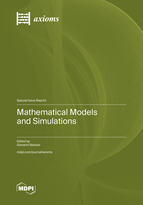Mathematical Models and Simulations
A special issue of Axioms (ISSN 2075-1680). This special issue belongs to the section "Mathematical Physics".
Deadline for manuscript submissions: closed (22 January 2024) | Viewed by 16653
Special Issue Editor
Interests: semiconductor modeling and simulations; kinetic models; numerical solutions of PDEs; Monte Carlo methods; optimization
Special Issues, Collections and Topics in MDPI journals
Special Issue Information
Dear Colleagues,
Mathematical models constitute a fundamental tool for the understanding of physical phenomena, biological systems, and finance and engineering. In addition to theoretical aspects, simulations play a primary role in applications, because they allow for the prediction of the behavior of quantities of interest.
The scope of this Special Issue is to collect papers in the field of mathematical physics, where different categories of mathematical models are presented both deterministic, i.e., based on ordinary or partial differential equations, and stochastic, i.e., defined by stochastic processes or based on stochastic differential equations. The study of mathematical aspects of the presented models is desirable. To provide realistic applications, the presence of numerical simulations is encouraged. Several numerical methods suited to the specific problem can be adopted, i.e., finite differences and finite volume schemes, finite elements, and discontinuous Galerkin and Monte Carlo methods. Usually, the simulations are performed by adopting real data for the parameters, and the models can also be optimized on datasets if available.
Dr. Giovanni Nastasi
Guest Editor
Manuscript Submission Information
Manuscripts should be submitted online at www.mdpi.com by registering and logging in to this website. Once you are registered, click here to go to the submission form. Manuscripts can be submitted until the deadline. All submissions that pass pre-check are peer-reviewed. Accepted papers will be published continuously in the journal (as soon as accepted) and will be listed together on the special issue website. Research articles, review articles as well as short communications are invited. For planned papers, a title and short abstract (about 100 words) can be sent to the Editorial Office for announcement on this website.
Submitted manuscripts should not have been published previously, nor be under consideration for publication elsewhere (except conference proceedings papers). All manuscripts are thoroughly refereed through a single-blind peer-review process. A guide for authors and other relevant information for submission of manuscripts is available on the Instructions for Authors page. Axioms is an international peer-reviewed open access monthly journal published by MDPI.
Please visit the Instructions for Authors page before submitting a manuscript. The Article Processing Charge (APC) for publication in this open access journal is 2400 CHF (Swiss Francs). Submitted papers should be well formatted and use good English. Authors may use MDPI's English editing service prior to publication or during author revisions.
Keywords
- mathematical models
- ordinary differential equations
- partial differential equations
- stochastic processes
- stochastic differential equations
- finite difference schemes
- finite volume schemes
- finite element method
- discontinuous Galerkin method
- Monte Carlo method
Related Special Issue
- Mathematical Models and Simulations II in Axioms (1 article)





